Kellysville, West Virginia
VGN Rwy. list | N&W Archives | Kellysville Info
Posts on Virginian Railway list
Hind-sight is 20/20. This wasn’t my observation, but rather one of the late R. D. Painter, N&W. Following the merger with the VGN, N&W built a connection with the VGN across the New River west of Glen Lyn. Eastward coal trains from Bluefield had to back thru the connection, crossing the New River to reach the VGN, then head east to Roanoke. For empty trains to Elmore, they merely headed thru the connection. Later this connection was changed so that eastbound coal trains from Bluefield merely headed across the river. Having sold the former VGN right-of-way to improve the alignment of U.S. 460, N&W then built a connection across the New River east of Narrows (and west of Celco).
But suppose N&W had built the connection, not east of Narrows, but rather to cross the New River east of Belspring to hook up with the VGN near the horseshoe curve mentioned ? Service to Celanese could be maintained thru the connection at Klotz (?) provided the former VGN was kept it place Klotz-Celco. The “pipe dream” connection was timetable west of the Whitethorne helper station and the climb to Merrimac Tunnel, so the pusher district would not have to be altered. Probably N&W would have restored double track Belspring and beyond, which would improve traffic flow. The former VGN track Klotz to the horseshoe curve would be retired.
Harry Bundy
Mon, Jun 30, 2008
Harry: You have the Kellysville connections backwards. The original connection allowed eastbounds to cross from N&W to Vgn. (I guess the westbound empties would have had to back to get from N&W to Vgn). The connection did not cross New River, but did allow N&W trains to cross it on the Vgn at Glen Lyn. Later, when the state of Virginia wanted the Vgn right of way through the narrows, The Kellysville connection was reversed, so that eastbound Vgn trains crossed over to N&W (and westbounds ran straight across too), and the new crossover east of Narrows got them back to the Vgn, crossing New River on a new bridge.
Jim Nichols
Mon, Jun 30, 2008
(I guess the westbound empties would have had to back to get from N&W to Vgn)
If needed they probably used the Potts Valley connector... or the Bluestone branch to Matoaka
Robb Fisher
Tue, Jul 1, 2008
After the the merger with the Virginian, it was desirable to run loaded coal trains over the VGN and the crossover was oriented for eastbound coal trains from Bluefield to move from the N&W main to the VGN main at Kellysville. Since empties were returned on the old N&W main, most went to Bluefield but if empties went to Princeton, then it was necessary to stop the train on the upgrade, back downgrade the empty train through the crossover, and then proceed upgrade to Princeton. A retired road foreman of engines confirmed that this was the normal procedure until the elimination of the VGN line between Kellysville and Narrows and the subsequnent connection instead of the crossover at Kellysville.
Bud Jeffries
July 1, 2008
Sometime, in the late ’60s I suppose, I saw and photographed one of these back-up moves to get an empty train to Elmore. There was a small manned tower (actually just a shanty) called “KV” at the junction on the Vgn side.
Jeff Sanders
July 2, 2008
Maybe the attached aerial view of Kellysville, WV will help. I hope the labels are self explanatory. One comment, the original arrangement should probably be called a “crossover” because it connected two parallel lines. The present arrangement should probably be called a “connection” inasmuch as the former VGN for several miles east of Kellysville has been removed to make way for the four-lane US 460.
The original crossover also included a bridge, since removed, over old US 460. The bridge over East River was still in place the last time I checked it, and it shows on the aerial view.
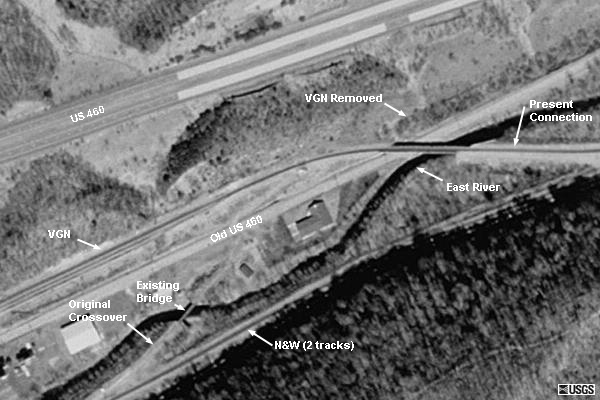
Gordon Hamilton
Tue, Jul 1, 2008
The bridge over the East River associated with now removed “crossover” (E-bound N&W to E-bound VGN) is still in place as George shows in the attachment. It can be driven over with a vehicle. Railway personnel use it to access the N&W on the far side of the East River for maintenance and such. It doesn’t have a solid deck. You drive on the bridge crossties. It is however very solid.
Ed Painter; from Narrows, VA living in Russellville, AR
Tue, Jul 1, 2008
An interesting tidbit to the original connection bridge at Kellysville. The original bridge over East River, after the new connection bridge was placed in service, was sold to the original Norfolk Southern Railway. The bridge was skewed but NS squared up the through girder span and it is now in use in Greenville, NC. It spans South Charles Ave right next to East Carolina University. You can see the bridge on Google Street View. The NS line is currently leased to Carolina Coastal Ry.
Doug Bess
I believe the bridge over East River on the original connection at Kellysville is still in place (see Google Earth). It was the bridge over the highway that was removed.
Gordon Hamilton
Gordon,
You are right, it was the bridge over old US 460.
Doug
Nov 17, 2010
Many years ago I remember a Ripley’s Believe it or Not item that went something like this:
A 100-car coal train of the Virginian Railway at Glen Lyn, Virginia, is in two counties of two states crossing two bridges over two rivers, and crossing another railroad twice, all at the same time.
Gordon Hamilton
Nov 18, 2010
Bluefield Daily Telegraph
August 16, 1911 (Wednesday)
VIRGINIAN TRAINS PASS THROUGH CITY
------
Make Detour From Matoaka to Big Stoney on Account of Cave-In At Hale Gap Tunnel
Bluefielders were given a chance yesterday to see Virginian passenger trains and perishable freight trains when they passed through this city making a detour from Matoaka to Big Stoney, on account of the falling in of the Hale Gap tunnel. The Bluefield railroad men are certainly a lot of loyal men, as it was impossible yesterday to find a single man who would admit that the Virginian equipment is as good as the Norfolk and Western equipment, when the two were placed side by side at the depot or in the railroad yard.
Two passenger trains, one eastbound and one westbound, went through Bluefield and will continue to do so until Monday, when it is believed the connection with the Norfolk and Western at Kelleysville [sic] will be completed. After Monday the Norfolk and Western tracks between Kelleysville and Big Stoney will be used until the Hale Gap tunnel is repaired, which may not be for two or three weeks.
The Virginian Railway Company has turned over the repair work to contractors and it is impossible to estimate the amount of work which will have to be done as it cannot be told when the sliding dirt will stop. It will be necessary to drive through the dirt and timber as progress is made, and then the engineers will have to devise some plan to keep the lining of the tunnel safe against future slides.
Raymond Du Puy, vice-president and general manager of the Virginian will go to the tunnel this morning on train No. 12 and will inspect the damage, which it is now impossible to estimate. A continual rumbling and roaring can be heard about the tunnel and ropes have been thrown about it to keep back the crowds of people who might be injured if they were to venture too close to the slipping mountain.
It is not known now whether the repairs to the tunnel can be completed in six weeks or six months. Engineers are undecided as to whether it will be necessary to make a ??* or whether the repairs can be made. It is believed the fall of muck and rock has affected the entire mountain, and engineers are anxious to go inside and see the real extent of the damage so they can make some estimate on what the possible cost will be.
The same tunnel gave the Virginian considerable trouble about two months ago when a fall occurred, which tied up the line up [sic] twenty-four hours. Wrecking crews repaired it at the time, but it appears the mountain could not be restrained as it suddenly gave way again without any warning. Engineer Richardson, whose westbound train of empties ran into the slide, narrowly escaped injuries, and if the slide had occurred a half hour later it is likely that a train of eighty cars of coal and a whole crew of trainmen would have been buried beneath the cave-in. Engineer Scott, who was to take a train of loads east, was delayed twenty-five minutes at Princeton, while some repairs were being made to his engine. This delay caused him to make a siding at Kelleysville instead of Rich Creek, with the result that he escaped going through the tunnel.
Yesterday a force of bridge men were at work building a bridge across the river at Kelleysville so that trains may be taken over it. It is hoped that trains will be detoured via Norcross over the Norfolk and Western to Kelleysville today, where they will be transferred back to the Virginian over the temporary bridge. It is not known how long this service will have to be continued.
*[The word was blurred on the microfilm.]
------
Gordon Hamilton
Sat, Apr 2, 2011 at 10:50 PM
[VirginianRailwayEnthusiasts] VGN in 1911--Through Bluefield
Bluefield Daily Telegraph
December 9, 1911
HALE [SIC] TUNNEL REOPENED
------
The Hale Tunnel on the Virginian Railway, which caved in about three months ago, has been opened for traffic. During the time that the tunnel was closed for repairs the Virginian Railway used the Norfolk and Western tracks connecting at Big Stoney Junction and running to Kelleysville [sic]. In order to prevent future cavings of tunnels the Virginian Railway has entered into a contract for the lining with concrete of a number of tunnels on the line. The work will take several months.
Gordon Hamilton
Sun, Jul 17, 2011 at 10:11 PM
[VirginianRailwayEnthusiasts] Virginian in 1911--Hales Gap Tunnel
From the Norfolk and Western Archives
[When the N&W Archives were in the Virginia Tech Libraries, Special Collections Department (and I had time), I was researching several different areas. In perusing a box of records, other correspondence files would look interesting, so I would take a look and jot down some notes. This is one such file on the tunnel cave-in. BBH]
Box 2.85, File 4571
Vgn. -- Hale’s Gap Tunnel cave-in
Letter from Raymond Dupuy thanking N&W for help, including “our connection near Kelleysville in order to get a detour track established.”
Letter from Johnson to Dupuy
“A portion of the road which you are using has about eight miles of single track”
September 25, 1911
Letter from Sup’t Transportation D.E. Spangler to N.D. Maher
“We detoured the first train for the Virginian Railway account of their tunnel trouble on Aug. 15th, 1911, and from that date to and including Sept. 20th, we have detoured a total of 405 Virginian Railway trains for which we should receive, at the rate of $1.00 per mile per train $9,080.61.”
Still detouring as of Sept. 25
Kellysville Information
The “town” of Kellysville, West Virginia, has been an important location on the railroad since the merger of the Norfolk & Western Railway and the Virginian Railway. It was one of the connection points between the two railroads that allowed traffic to move to take advantage of one line over the other. At Kellysville, eastbound coal trains crossed to the VGN to take advantage of the easier grade (Merrimac vs. Christiansburg) to cross from the New River Valley to the Roanoke Valley.
The original connection crossed from the N&W westbound main to the Virginian track, favoring eastbound movements. The line crossed the East River and U.S. 460, then tied into the VGN to continue through Hale’s Gap Tunnel, across a trestle into Glen Lyn, Va., then across another trestle over the New River.
At that time, U.S. 460 was a two-lane highway that twisted and turned high above the river from Narrows to Glen Lyn, only dropping down to reach Rich Creek. The Virginia Department of Highways saw an easy way to improve the highway by using a railroad right of way down near river level. The Virginian was selected as the best candidate and was abandoned by the N&W from Kellysville to Narrows, Va. The West Virginia section was totally removed by the West Virginia highway department when U.S. 460 was four-laned from Glen Lyn through Hale’s Gap, and then continued to Princeton on an entirely new route.
The connection from the N&W to the VGN was moved east to the east side of Narrows, still a connection favoring eastbound traffic. The connection at Kellysville was changed to get traffic from the Virginian to the N&W. At about the same location where the original connection was made, the VGN was routed across the highway, across the East River, and tied into the N&W westbound main.
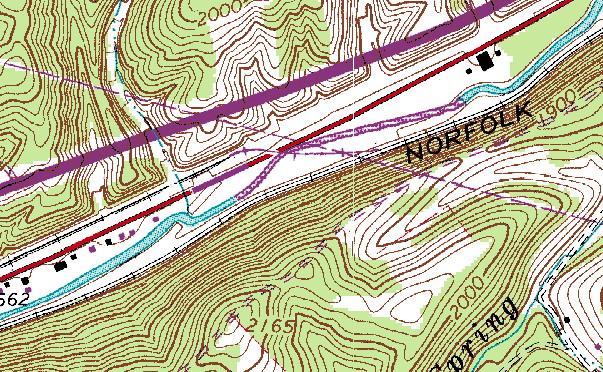
Oakvale, W.Va.-Va 7.5-minute quad -- 1965, photorevised 1977
The image below (from the West Virginia Department of Environmental Protection web site at http://gis.wvdep.org/ [Aerial Photo Browser]) shows both the old and the current connection.
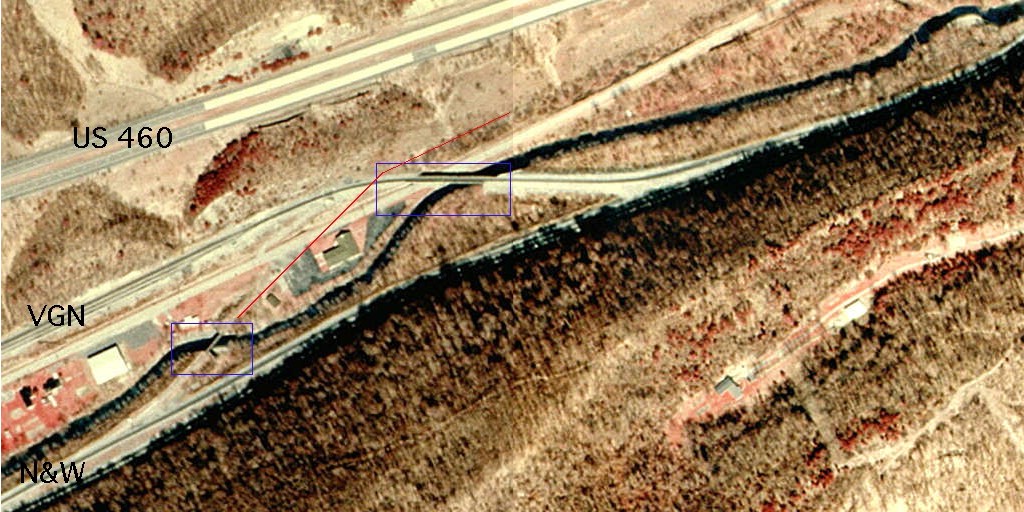
The top of the image is north and the right side is east. The N&W tracks are at the bottom of the photo. The original connection is in the smaller blue rectangle and the red line shows the approximate location of the connection. The embankment was removed when the new connection was built; a church and its parking lot occupy the space now. The crossing of the East River still exists and is used for access to the junction. The current crossing is in the larger blue rectangle.
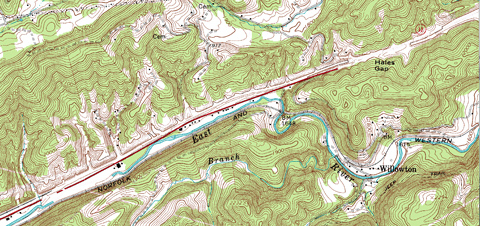
Oakvale, W.Va. 7.5-minute quad -- 1965, photorevised 1977
Unphotorevised via the magic of PhotoShop, removing the purple overlay for the new location of U.S. 460. The route of the Virginian on east from Kellysville through Hales Gap is easy to see now. The route of the N&W/VGN crossover can also be seen. It also appears that the East River channel was shifted to make room for the new junction when the connection was reversed.
The West Virginia Department of Environmental Protection web site also has historical topo maps (as do other sites). That site has the Narrows quad from 1932.
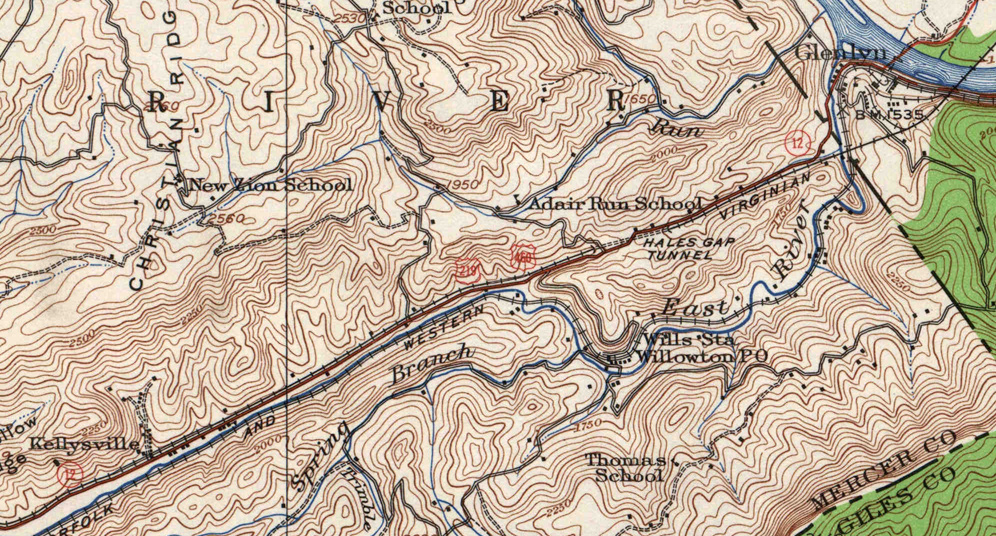
Narrows, Va. 7.5-minute quad -- 1932, cropped, click on the image for larger version (1.3 MB file)
The orange line is the Virginian main line (give or take a minor curve or two). If one drives to the “top” of Glen Lyn on Va. 704, you can stand in the middle of the right of way and see where it crossed that point of land where the Apco plant sits, that the N&W wraps around as it transitions from the East River to the New River. When you look in one direction, you can see where the VGN headed across the New River after passing through a small cut. Apco Rd. is on one siding that is shown on the 1932 topo map. If you head down Thompson Lane, you can (or could) reach the end of land where the bridge abutment was and the other siding into the Apco plant dropped down the hillside. In the other direction, the cut shows up clearly in the Google aerial photo as the VGN headed west to cross another high trestle over the N&W and the East River and continued up the grade to Hale’s Gap and the tunnel. The highway, in the meantime, was down in the valley next to the N&W and the river and starting to climb pretty much on the same location it is today. The highway climbed to the gap and crossed the tunnel and changed sides of the railroad. The west portal of the tunnel appears to be just west of where Adair Run Road and Goodwins Chapel Road intersect with today’s four-lane U.S. 460. Goodwin’s Chapel is of course the original highway, which continues through Kellysville. The construction of the new, improved U.S. 460 from the West Virginia state line to Priceton obliterated the tunnel and a portion of the VGN to the connection at Kellyville.
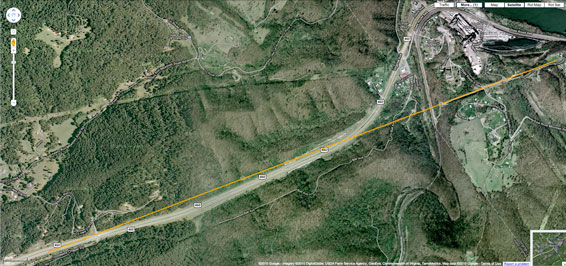
Google maps view click on the image for larger version
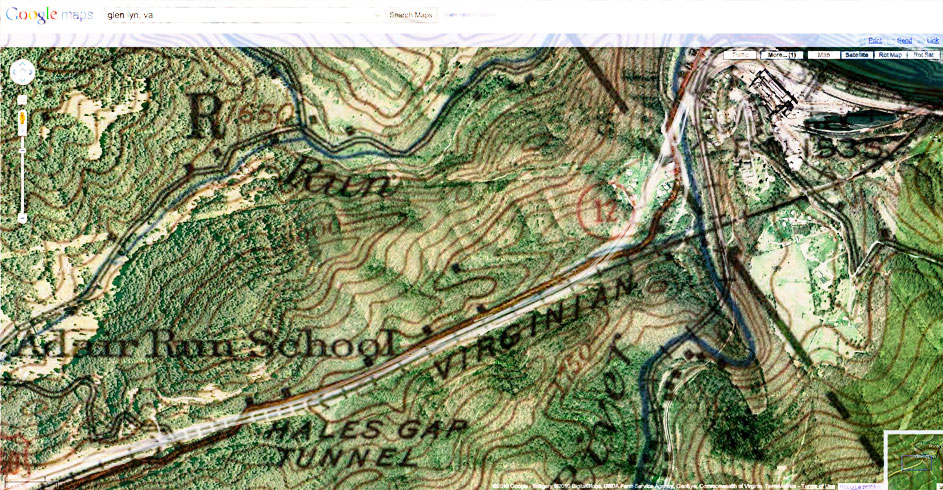
Google maps view with 1932 topo map overlaid
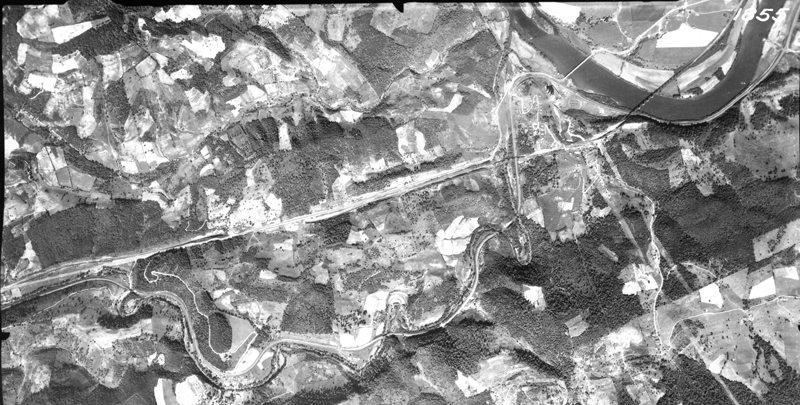
Undated aerial photo of Glen Lyn to Kellysville. The photo is from a collection of Giles County aerial photos of the New River in the Virginia Tech library.
From H. Reid’s Virginian Railway appendix “A historical chronology, 1898-1959” comes several items of interest.
1909 “Three days later [June 19], East River yard in Mercer County became known as Kellysville.”
1912 “Non-self-supporting tunnels to be concrete lined; Hales Gap, Slate Hill and New River so treated.”
Bruce Harper, July 1, 2007
Other Virginian Research
See the Virginian Info page for other topics.
